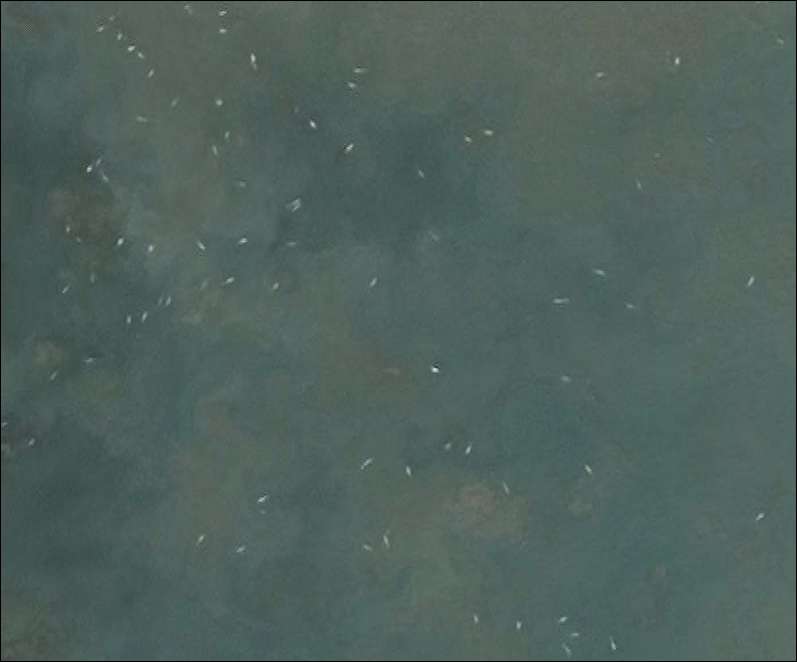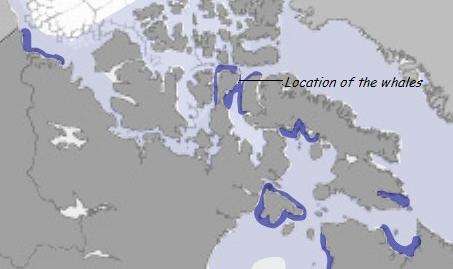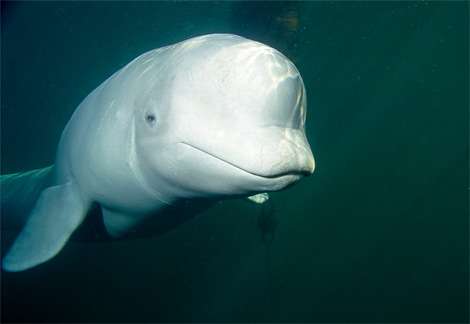Beluga whales in Erwin Bay, Somerset Island, Nunavut, Canada
Mar 30, 2015 22:48:41 GMT
diane9247, Barnstormer66 (Angel), and 1 more like this
Post by Hill on Mar 30, 2015 22:48:41 GMT
Looking around in the less populated areas of the world can be productive too. I had to study this area for a few minutes before it became apparent that what I was seeing was a large pod of belugas feeding on their summer grounds in the shallow waters of Elwin Bay on Somerset Island. Below is a screen capture of the view you will see in the attachment. I used a grid and conservatively count 335 whales in the bay, and there must be some submerged deeply enough in the murky water to be missed. If you look at the attachment you can see how the water becomes muddy as the belugas stir up bottom sediments searching for worms and crustaceans.Belugas feed in water up to 1000 feet deep in winter, but gather in large pods of up to 1000 or more on their summer feeding grounds.


Purple areas are the shallows where Belugas are found in Northern Canada.
Belugas are very gregarious, tending to travel in groups of between 2-15 individuals, with very tight mother/calf associations. These groups are either all cows/calves, or all bulls, the latter of which can extend into larger units of around 500 individuals. Amassed groups of thousands have also been reported, particularly during mating season. This fun-loving species is usually quiet at the surface, but they can become quite noisy and playful in their shallow summer grounds displaying lobtailing and flipper-slapping behaviors.
Source

Source: nationalgeographic.com
Distribution and Migration: Belugas are found mostly in Arctic and subarctic waters as well as the St. Lawrence River. They congregate and travel in groups from as few as 2-3 to as many as several hundred. Some are migratory within their limited range while others remain residents of a particular area. They are found close to shore or in the open sea. During the summer months in some areas they gather in the estuaries of rivers to feed and calve.
Source
The beluga's diet is varied, and consists of small squid, crabs, clams, shrimp, sandworms, and various kinds of fish such as capelin, sandlance, and polar and arctic cod. It is especially fond of young salmon, and groups of belugas sometimes gather at the mouths of rivers to feed on the salmon as they return from their fresh water spawning grounds to the sea. A beluga consumes 50-60 pounds of food a day. It has about 10 conical shaped teeth on each side of its upper and lower jaw. Because it swallows its food whole, the beluga's teeth are not used for chewing, but for grasping and holding prey.
Source
On the north shore of the island at 74.1333 N, 93.8833 W lies Cunningham Inlet, a popular ecotourism destination for, among other things, watching Belugas. See this Panoramio photo by Tessum Weber.

Google Earth screen capture

Purple areas are the shallows where Belugas are found in Northern Canada.
Belugas are very gregarious, tending to travel in groups of between 2-15 individuals, with very tight mother/calf associations. These groups are either all cows/calves, or all bulls, the latter of which can extend into larger units of around 500 individuals. Amassed groups of thousands have also been reported, particularly during mating season. This fun-loving species is usually quiet at the surface, but they can become quite noisy and playful in their shallow summer grounds displaying lobtailing and flipper-slapping behaviors.
Source

Source: nationalgeographic.com
Distribution and Migration: Belugas are found mostly in Arctic and subarctic waters as well as the St. Lawrence River. They congregate and travel in groups from as few as 2-3 to as many as several hundred. Some are migratory within their limited range while others remain residents of a particular area. They are found close to shore or in the open sea. During the summer months in some areas they gather in the estuaries of rivers to feed and calve.
Source
The beluga's diet is varied, and consists of small squid, crabs, clams, shrimp, sandworms, and various kinds of fish such as capelin, sandlance, and polar and arctic cod. It is especially fond of young salmon, and groups of belugas sometimes gather at the mouths of rivers to feed on the salmon as they return from their fresh water spawning grounds to the sea. A beluga consumes 50-60 pounds of food a day. It has about 10 conical shaped teeth on each side of its upper and lower jaw. Because it swallows its food whole, the beluga's teeth are not used for chewing, but for grasping and holding prey.
Source
On the north shore of the island at 74.1333 N, 93.8833 W lies Cunningham Inlet, a popular ecotourism destination for, among other things, watching Belugas. See this Panoramio photo by Tessum Weber.
